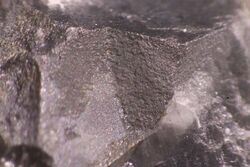Chemistry:Crookesite
From HandWiki
Short description: Selenide of copper, thallium and silver
| Crookesite | |
|---|---|
 | |
| General | |
| Category | Selenide mineral |
| Formula (repeating unit) | Cu7(Tl, Ag)Se4 |
| Strunz classification | 2.BD.50 |
| Crystal system | Tetragonal |
| Crystal class | Disphenoidal (4) H-M symbol: (4) |
| Space group | I4 |
| Identification | |
| Color | Lead-gray |
| Crystal habit | As finely divided, disseminated specks, and as small veinlets. |
| Cleavage | Good, two at right angles |
| Fracture | Brittle |
| Mohs scale hardness | 2.5–3 |
| |re|er}} | Metallic |
| Diaphaneity | Opaque |
| Specific gravity | 6.90 |
| References | [1][2] |
Crookesite is a selenide mineral composed of copper and selenium with variable thallium and silver.
Characteristics
Its chemical formula is reported either as Cu7(Tl, Ag)Se4 or (Cu, Tl, Ag)2Se.[4] It is formed by precipitation from hydrothermal fluids, and contains by mass: 16.3% Tl, 47.3% Cu, 2.9% Ag, and 33.6% Se.[1]
Crookesite is an opaque, bluish grey to pink toned brown metallic mineral crystallizing in the tetragonal system. It has a Mohs hardness of 2.5 to 3 and a specific gravity of 6.9.
Name and discovery
It was discovered in 1866 in Skrikerum, Sweden and named for Sir William Crookes (1832–1919), the discoverer of the element thallium.[1]
See also
References
- ↑ 1.0 1.1 1.2 Webmineral site
- ↑ Handbook of Mineralogy
- ↑ Warr, L.N. (2021). "IMA–CNMNC approved mineral symbols". Mineralogical Magazine 85 (3): 291–320. doi:10.1180/mgm.2021.43. Bibcode: 2021MinM...85..291W.
- ↑ http://www.mindat.org/min-1159.html Mindat
- Berger, Rolf A.; Sobott, Robert J. (1987). "Characterization of TlCu7S4, a crookesite analogue". Monatshefte für Chemie 118 (8–9): 967–972. doi:10.1007/BF00815324.
- Berger, R..A. (1987). "Crookesite and sabatierite in a new light. A crystallographer's comment". Zeitschrift für Kristallographie 181 (1–4): 241–249. doi:10.1524/zkri.1987.181.1-4.241. Bibcode: 1987ZK....181..241B. http://rruff.geo.arizona.edu/doclib/zk/vol181/ZK181_241.pdf.
 |

